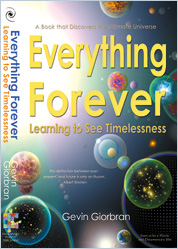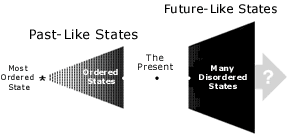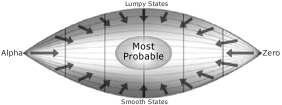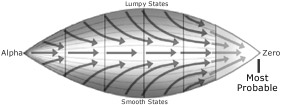| |||||||||||||
"
If we want to solve a problem that we have never solved before, we must leave the door to the unknown ajar."óRichard Feynman
From The Book:
Everything Forever:
Learning to
See Timelessness
"While it is somewhat difficult for us to visualize a four-dimensional space, mathematically speaking one can construct spaces of any number of dimensions. Space-time is such a four-dimensional space, which uses as "directions" length, width, depth, and time.
ó Mario Livio
The Accelerating Universe
"You and I are essentially infinite choice makers. In every moment of our existence, we are in that field of all possibilities where we have access to an infinity of choices."
óDeepak Chopra

|
Ultimately we should expect that the structure of the universe we experience is directly the product of what is possible. In any scenario, a big bang, intelligent design, or creation, we should expect the overall big picture so to speak reasonably leads to the universe we experience, be that God, Mother Nature, or whatever that big picture is. If we take into consideration how the success of quantum mechanics and the second law both indicate that our universe is influenced by probabilities, then it starts to make sense that the really big picture is shaping every small part of what we experience. The really big picture shapes our past and our future, while both past and the future possibilities shape the present. What we are going to do next is ask a question concerning the boundaries of a wedge. The classical wedge shape is conveyed by a top and bottom boundary expanding outward from a point. Julian Barbour diagrams his wedge with squiggly lines. Others have drawn straight lines. Here we are discovering a reversed wedge in our future. But what do the lines themselves represent? What actually defines the top and bottom edges of the wedge?
The Smooth Extreme If we could watch the big bang event from a distance, a view from nowhere in particular, a question that would arise would be, why didn't the early universe remain perfectly smooth as it expanded? It is an old question in astronomy and cosmology. Instead of remaining smooth, very small variations in the rate of expansion produced minute differences, which gravity then amplified. The more dense areas underwent a phase transition and became matter, and eventually transformed into galaxies and galaxy clusters. Without these mysterious fluctuations in the density of space, the universe would have remained perfectly uniform. Gravity would never have been a distinct force of nature since gravityís influence would have been evenly distributed over the entire volume of space-time. Of course life would not exist in such a universe to note the difference.
The question of why the universe isnít smooth has led to a vague recognition in cosmology that a smooth configuration is an extreme of possibility. Physicists donít talk about double or hyper smooth universes. There isnít anything beyond perfectly smooth. It is just a natural boundary to what is possible at any given average cosmological density. Every other possible pattern is less smooth. So in the same way Alpha and zero create boundaries for our past and future, these smooth states form a sort of outer membrane to the whole of possibilities, beyond which no other possibilities exist. This line in the sand even represents the outer edge of reality. The Lumpy Extreme The next step along this same way of thinking is to recognize that another extreme exists opposite of the smooth extreme. Adjacent the wide axis from Alpha to ZAT, opposite to the smooth extreme, there is an extreme case of lumpiness, even if such a state is initially difficult to envision. We know the early universe did not remain smooth. Small fluctuations caused the universe to become moderately lumpy and yet isotropic, meaning that matter was for some reason distributed very equally throughout the entire universe. The original variations in density were moderate and similar enough to create the distribution of over a hundred billion galaxies presently observed by telescopes. But how lumpy could the universe have been had conditions been more extreme?
Some regions of the universe might have expanded during the big bang only for the first billion or so years, and then collapsed, forming ominous black holes unlike anything we observe today. Or we might imagine all the protons of the universe combined into a single giant proton particle, and all of the electrons combined into a super electron, and imagine this giant atom as the whole universe. Of course such an extreme division of charged particles doesn't seem normal or physically possible to us, however, simply imagine if like particles were attracted to each other while opposite particles repelled. Charged matter would naturally divide apart into two groups. The lumpy extreme doesn't seem physically possible from our region of normalcy living in such a moderately lumpy universe, but keep in mind that what seems possible to us is a product of what we know to be probable. The whole point of this rendering is finding the outer edge of the possible, even if such a state is highly improbable or even impossible. All that matters is that the lumpy extreme is conceivable, which establishes a second outer membrane in the realm of all possibilities directly opposite the smooth extreme. And we of course naturally find ourselves in the middle between extremes.
The Balance Between Extremes 
The density variations in the early universe that became galaxies and us are usually attributed to quantum instability but there may be a simpler way of looking at the mystery, a way of understanding why there is quantum instability. If mother nature is always choosing amongst all the patterns that are possible for each new moment of time, then the smooth path is only one possibility among the many alternatives where the universe doesnít remain smooth and instead becomes lumpy. In order for the early universe to have remained perfectly smooth for any extended period of time, the selection process would have had to choose the one perfectly smooth pattern for each and every new moment. Mother nature would have had to pull that particular pattern out of the hat again and again, somewhat like the same person winning the lottery every day, every hour, every minute, every second.
Instead, the flow of time is naturally held within a central region between the improbable outer extremes. If the path of time strays toward the lumpy side, the group of states which are smoother than the present inevitably grows in size, so the comparison between groups might become 60/40 percent. If sixty percent of possibilities are more smooth than the present, the probability for time to turn back toward the smooth side grows stronger. In fact the farther that time moves away from the balance point in between extremes, in any direction, the greater the probability for time to turn back toward middle ground. The most probable location in pattern space is always the point of balance between extremes.
So notice that we have boundaries now in every direction of possibility. The realm of possibilities is closed and bounded in every direction by extremes. There are no possibilities more smooth or more lumpy than those represented in this bulb. There are no states more dense than Alpha, and there are no states more flat or empty of matter than absolute zero. There exists an unfathomable measure of possible states in between these extremes, to an extent beyond imagination, but not beyond structure. To
the Greatest Mystery A well known problem with the second law is that it falls short of explaining why time begins from the ordered side of what is possible. It merely explains that if a universe for some reason begins ordered then time will move toward disorder. As Stephen Hawking explains:
We normally assume something in the past created the present, but notice how Boltzmann's way of explaining entropy suggests the future is creating the flow of time. The idea that the future is causing time's arrow is logically unavoidable. If we estimate the location of our own universe within the wedge model, this naturally splits the whole of possibilities into two groups, a group of states which are more ordered than the present, which we can refer to as past-like states, and a group of states which are more disordered than the present, which according to Boltzmann are future-like states. As shown below, we are splitting all possibilities into two groups, and according to Boltzmann the future-like set is much larger. Consequently that group is thought to pull time into those states.
Figure 5: Even the outdated wedge model includes a past-like group and a future-like group of possibilities. Time is thought to move toward disorder because there are so many more disordered possibilities. The soaps model I have explained so far can also be split apart by the present, to form two groups. Logically we have to place the point of our own present very near to zero, because we know the universe is only a few degrees away from zero, and because there is already so much empty space between the galaxies, the stars, and even particles of matter.
Figure 6: If the past-like set of states is larger than the future-like set of states, then why is time traveling toward a smaller group of possibilities. Only now we have exposed a problem with the soaps description developed so far. We can no longer detect a reason for why time is traveling, even accelerating, toward zero. If we imaginatively transport ahead in time and look at what is probable from the standpoint of zero, then all other possibilities lie in the opposite direction away from zero toward Alpha. In fact from the location shown, the past-like group of states is larger than the future-like group.
In considering the wedge model, time is at least trying to find a state of balance, even if the flow of time for the universe as a whole cannot find a state of balance because there is an ever increasing quantity of disordered states. Hence Boltzmannís claim that systems move toward disorder always holds true regardless of where the present is located in the model. The mistake however is the assumption that the measure of disordered states is unbounded. First that belief conflicts with our observations that time is accelerating toward the extremities of zero. Second, in simply knowing there is an absolute zero in physics, we can reason logically that absolute zero exists out there in the future beyond any imagined bulk of disordered states. So if the whole of possible states is bounded by zero, why is time traveling toward an extreme at the edge of what is possible? Speaking probabilistically, any given state that is an extreme is highly unstable compared to a state in the middle balanced between extremes. The perfect middle is a Cosmic Equilibrium State. Below in figure eight arrows represent the directions of probability. That balanced center should be the primary attractor for all probabilistically governed universes.
However, time is clearly not moving toward the middle between Alpha and Zero. Time is long past that center point and still is moving toward zero. Time is even accelerating toward zero. Why then is time moving toward zero? There has to be a very good reason. And it has to be something that makes perfect sense once we realize it, because we are considering something very basic about reality.So here we are forced to finally ask a question that has been lying in wait since the discovery of accelerating expansion surfaced in the mainstream of science in 1998. Why is the arrow of time aimed directly at absolute zero, and presently even accelerating toward zero? Why is time attracted to zero? What causes absolute zero to have such a powerful influence over time? What larger role does absolute zero play in the top-down picture of reality?
Next page: Everything Moves Toward Balance
This Essay Taken from Chapter Twelve from the book Everything Forever.
Contents This page last updated Mar 25th, 2007 |
| Your welcome to send an e-mail and share your thoughts when you're done reading. |
|
Homepage | Part One | Part Two | Part Three | Part Four | Part Five | Contents | Backward | Forward | |
|
© Gevin Giorbran, Copyright 1996 - 2007 All rights reserved. Privacy Policy | Usage Policy |
|
|











 The
real magic behind Boltzmannís way of thinking about possibilities is the approach of splitting up the whole of
possibilities into two large groups and then comparing those groups. The larger group of possibilities will always be
the dominant attractor. In fact, the deeply simplistic principle that Boltzmann originally conjured up to develop the
statistical second law was the principle that the free flow of time will move toward whatever ultimate balance exists in
the whole of possibilities.
The
real magic behind Boltzmannís way of thinking about possibilities is the approach of splitting up the whole of
possibilities into two large groups and then comparing those groups. The larger group of possibilities will always be
the dominant attractor. In fact, the deeply simplistic principle that Boltzmann originally conjured up to develop the
statistical second law was the principle that the free flow of time will move toward whatever ultimate balance exists in
the whole of possibilities. 

